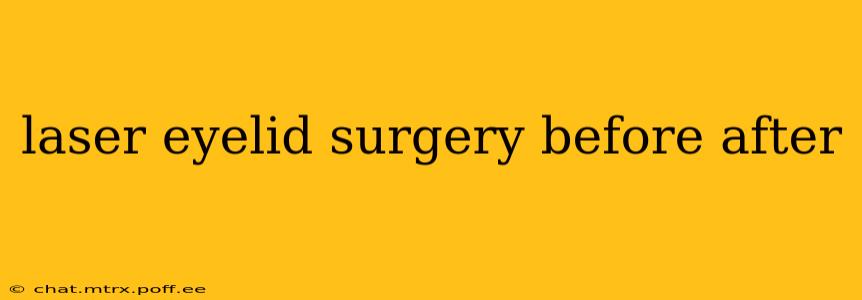Laser eyelid surgery, also known as laser blepharoplasty, is a popular cosmetic procedure aiming to rejuvenate the eyelids by addressing issues like sagging skin, excess fat, and wrinkles. This procedure offers a less invasive alternative to traditional blepharoplasty, often resulting in faster recovery times and less noticeable scarring. However, it's crucial to understand what to expect before, during, and after the procedure to make an informed decision. This comprehensive guide explores the before-and-after aspects of laser blepharoplasty, addressing common questions and concerns.
What Does Laser Blepharoplasty Involve?
Laser blepharoplasty utilizes a laser to precisely remove excess skin and fat from the upper and/or lower eyelids. The laser's precision minimizes bleeding and trauma compared to traditional surgical methods using a scalpel. The laser also cauterizes blood vessels as it cuts, further reducing bleeding and swelling. The procedure typically focuses on:
- Upper eyelids: Removing excess skin and fat that can cause a hooded appearance or droopiness, improving vision and creating a more youthful and refreshed look.
- Lower eyelids: Addressing puffiness, wrinkles, and sagging skin, resulting in a smoother, more contoured appearance. This often involves removing excess fat pockets and tightening the skin.
The specific techniques used can vary depending on the individual's needs and the surgeon's preferences.
What are the Benefits of Laser Blepharoplasty?
- Less Invasive: Compared to traditional blepharoplasty, laser blepharoplasty is often less invasive, leading to reduced discomfort and faster recovery.
- Reduced Swelling and Bruising: The precise nature of the laser minimizes bleeding, often resulting in less swelling and bruising post-surgery.
- Faster Recovery Time: Patients often experience a quicker recovery compared to traditional methods, with a faster return to normal activities.
- Minimally Invasive Scarring: Laser incisions tend to be smaller and heal more subtly, leaving minimal scarring.
- Improved Vision: For those with excess eyelid skin affecting their vision, laser blepharoplasty can significantly improve sight.
What to Expect Before Laser Blepharoplasty?
Before undergoing the procedure, a thorough consultation with a qualified and experienced surgeon is crucial. During this consultation, the surgeon will:
- Assess your eyelid condition: They will evaluate the degree of excess skin, fat, and wrinkles to determine the best treatment approach.
- Discuss your expectations: Open communication about your goals and concerns is paramount to ensure realistic expectations.
- Review your medical history: The surgeon will inquire about any medical conditions, allergies, and medications you are taking.
- Explain the procedure and recovery: They will clearly explain the procedure's details, risks, and potential complications.
Pre-operative instructions may include avoiding certain medications, such as blood thinners, and ceasing smoking or alcohol consumption.
What is the Recovery Process Like After Laser Blepharoplasty?
Recovery time varies depending on the extent of the procedure and individual healing rates. Generally, you can expect:
- Initial Swelling and Bruising: Some swelling and bruising are common in the first few days after surgery.
- Discomfort: Mild discomfort is manageable with prescribed pain medication.
- Gradual Improvement: Over several weeks, the swelling and bruising will gradually subside, and the final results will become more apparent.
- Follow-up Appointments: Regular follow-up appointments with your surgeon are essential to monitor healing progress.
It's important to follow post-operative instructions diligently, including applying cold compresses, using prescribed eye drops, and avoiding strenuous activity.
What are the Risks and Complications Associated with Laser Blepharoplasty?
As with any surgical procedure, laser blepharoplasty carries potential risks and complications, including:
- Infection: The risk of infection can be minimized with proper hygiene and adherence to post-operative instructions.
- Bleeding: Although laser surgery minimizes bleeding, some bleeding is possible.
- Dry Eyes: Some patients may experience temporary dry eyes after surgery.
- Asymmetry: Slight asymmetry is possible, but skilled surgeons strive to minimize this risk.
- Scarring: While laser blepharoplasty minimizes scarring, some scarring may occur.
- Eyelid Numbness: Temporary numbness around the eyelids is possible, typically resolving over time.
How Long Do the Results of Laser Blepharoplasty Last?
The longevity of laser blepharoplasty results varies depending on several factors, including age, genetics, sun exposure, and lifestyle. While it cannot halt the natural aging process entirely, the results can last for several years.
How Much Does Laser Blepharoplasty Cost?
The cost of laser blepharoplasty can vary widely depending on several factors, including the surgeon's fees, anesthesia costs, and the location of the clinic. It's essential to obtain a comprehensive cost estimate during your initial consultation.
Are There Alternatives to Laser Blepharoplasty?
Yes, other treatments can address some of the concerns addressed by laser blepharoplasty. These include:
- Non-surgical treatments: Botox injections and fillers can help improve wrinkles and skin laxity but do not address excess skin.
- Traditional blepharoplasty: This surgical procedure provides more extensive correction but involves longer recovery times and more pronounced scarring.
Choosing the right approach depends on your specific needs and preferences. A comprehensive consultation with a board-certified plastic surgeon is crucial for determining the best treatment path.
How Long is the Recovery Time for Laser Blepharoplasty?
Recovery times are typically shorter with laser blepharoplasty compared to traditional surgery. Most patients can resume their normal activities within a week or two, but swelling and bruising can take several weeks to completely resolve. Individual healing varies.
What is the Difference Between Laser Blepharoplasty and Traditional Blepharoplasty?
The primary difference lies in the technique used. Laser blepharoplasty uses a laser to make incisions and cauterize blood vessels, resulting in less bleeding and swelling, faster recovery, and less noticeable scarring. Traditional blepharoplasty uses a scalpel. The extent of the procedure and the areas addressed can be similar in both techniques.
This information is for educational purposes only and does not constitute medical advice. Consult a qualified healthcare professional for personalized advice and treatment. Remember to always choose a board-certified plastic surgeon for any cosmetic procedure.
